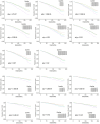Gut microbe-derived metabolites and the risk of cardiovascular disease in the METSIM cohort
- PMID: 39149211
- PMCID: PMC11324590
- DOI: 10.3389/fmicb.2024.1411328
Gut microbe-derived metabolites and the risk of cardiovascular disease in the METSIM cohort
Abstract
Background: An association between gut microbes and cardiovascular disease (CVD) has been established, but the underlying mechanisms remain largely unknown.
Methods: We conducted a secondary analysis of the cross-sectional data obtained from the Metabolic Syndrome in Men (METSIM) population-based cohort of 10,194 Finnish men (age = 57.65 ± 7.12 years). We tested the levels of circulating gut microbe-derived metabolites as predictors of CVD, ischemic cerebrovascular accident (CVA), and myocardial infarction (MI). The Kaplan-Meier method was used to estimate the time from the participants' first outpatient clinic visit to the occurrence of adverse outcomes. The associations between metabolite levels and the outcomes were assessed using Cox proportional hazard models.
Results: During a median follow-up period of 200 months, 979 participants experienced CVD, 397 experienced CVA, and 548 experienced MI. After adjusting for traditional risk factors and correcting for multiple comparisons, higher plasma levels of succinate [quartile 4 vs. quartile 1; adjusted hazard ratio, aHR = 1.30, (confidence interval (CI), 1.10-1.53) p = 0.0003, adjusted p = 0.01] were significantly associated with the risk of CVD. High plasma levels of ursodeoxycholic acid (UDCA) (quartile 3 vs. quartile 1); [aHR = 1.68, (CI, 1.26-2.2); p = 0.0003, adj. p = 0.01] were associated with a higher risk of CVA. Furthermore, as a continuous variable, succinate was associated with a 10% decrease in the risk of CVD [aHR = 0.9; (CI, 0.84-0.97); p = 0.008] and a 15% decrease in the risk of MI [aHR = 0.85, (CI, 0.77-0.93); p = 0.0007].
Conclusion: Gut microbe-derived metabolites, succinate, and ursodeoxycholic acid were associated with CVD, MI, and CVA, respectively. Regulating the gut microbes may represent a potential therapeutic target for modulating CVD and CVA.
Keywords: cardiovascular disease; gut metabolites; myocardial infarction; stroke; succinate; ursodeoxycholic acid.
Copyright © 2024 Mirzaei, DeVon, Cantor, Cupido, Fernandes Silva, Laakso and Lusis.
Conflict of interest statement
The authors declare that the research was conducted in the absence of any commercial or financial relationships that could be construed as a potential conflict of interest.
Figures



